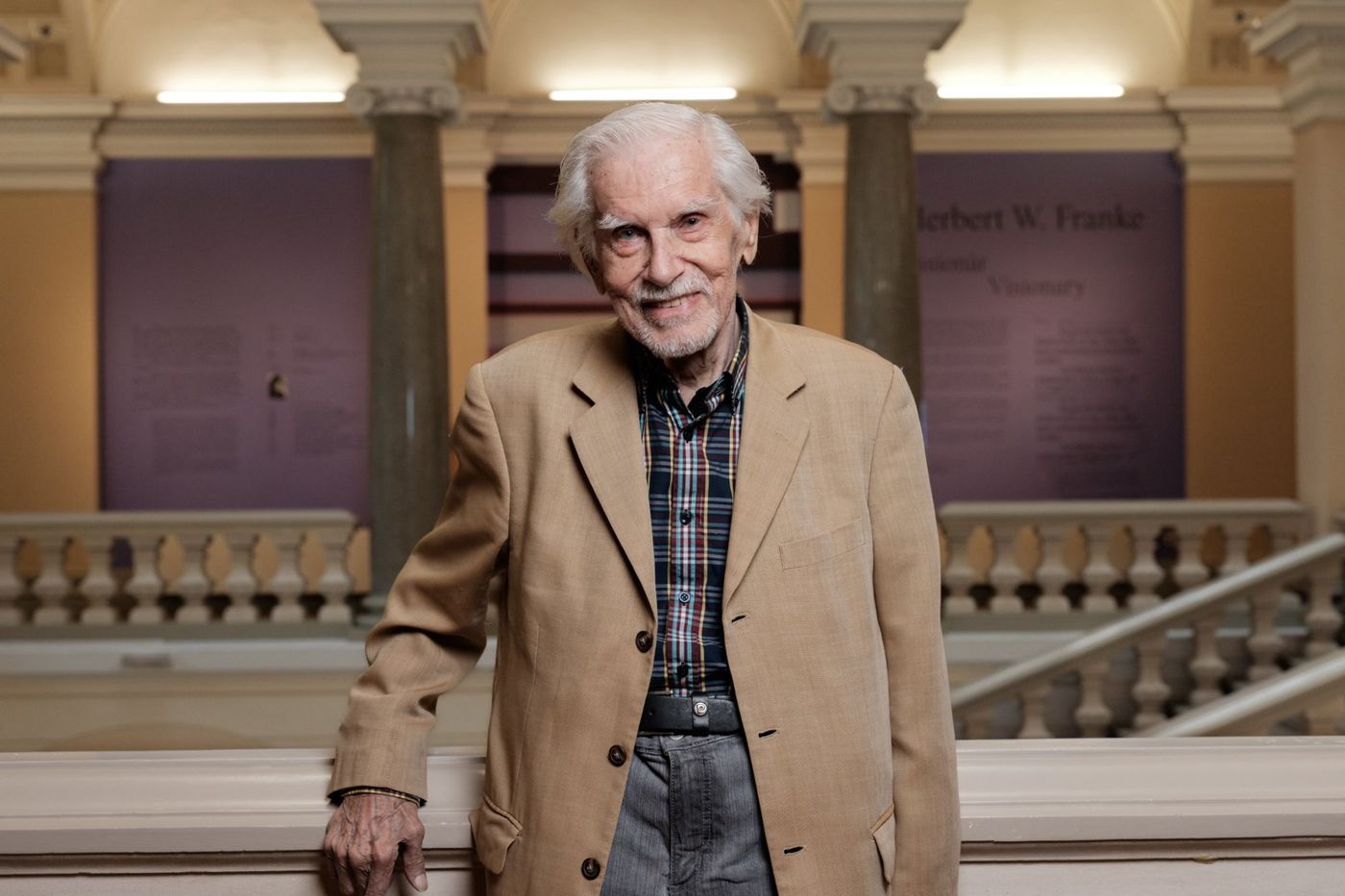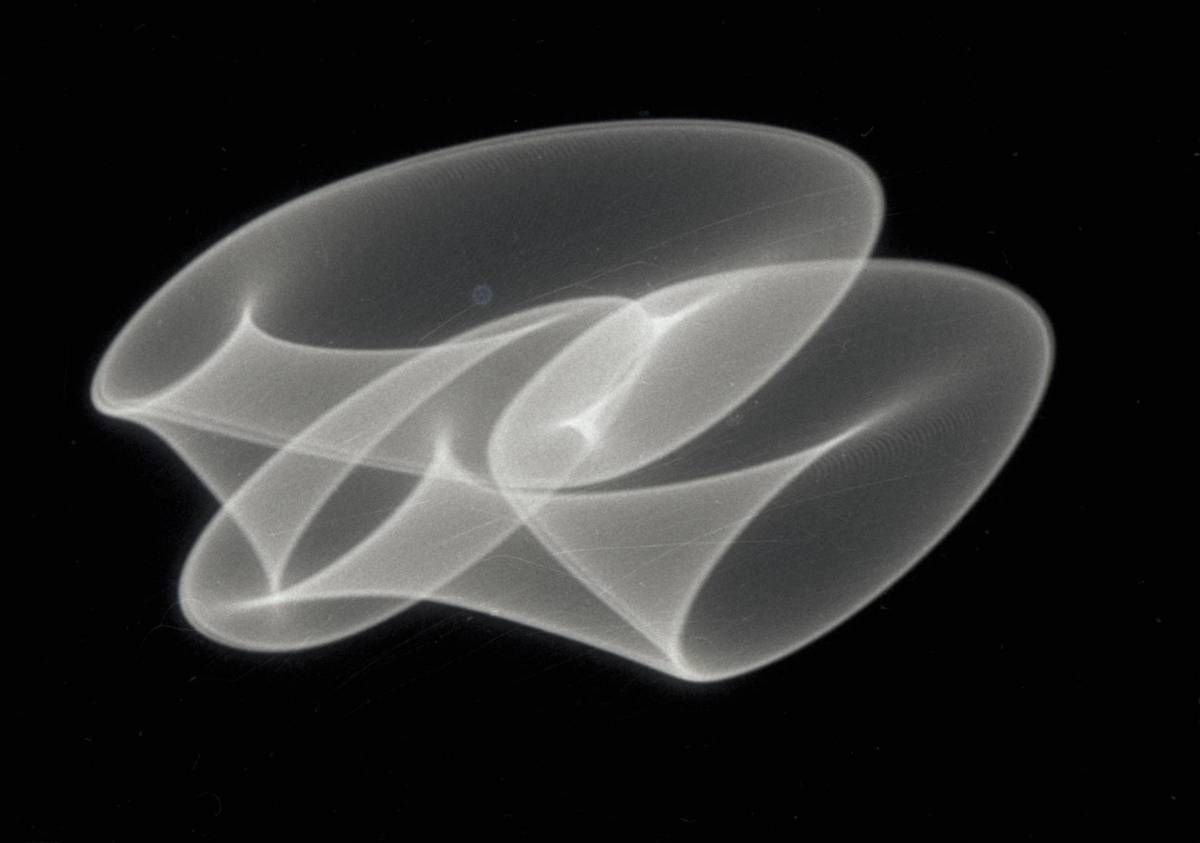
我們是你從Web2到Web3的旅伴,一起發掘NFT藝術的浪漫。 聯絡我們:c2x3.nftpress@gmail.com
95-year-old computer artist Herbert W. Franke, why did he switch to making NFTs?

The 95-year-old Austrian artist Herbert W. Franke (1927/05/14 ~ 2022/07/16) used algorithms and computer programs to turn mathematics into art, and has recently caused a sensation in the art world and cryptocurrency field.
Last month (June 2022), the physicist and science fiction writer exhibited one of the most talked about digital artworks at the blockchain company Tezos booth at Art Basel. Titled MONDRIAN (1979), the work was programmed using one of the first home computers, and pays homage to artist Piet Mondrian's representative geometric figures.
Franke, who studied physics in Vienna after World War II, started working at Siemens in 1953, and he experimented with photography after get off work. A few days before Basel, Franke selected 100 images from his famous series Math Art (1980-95) to launch NFTs on the Quantum platform. The airdrop was to commemorate his May 14 birthday and to raise money for his foundation. The NFT sold out in 30 seconds, and the likes of pioneering blockchain artist Kevin Abosch bought some.
Earlier this year, at the Francisco Carolinum Gallery in Linz, Austria, there was an exhibition examining Franke's artworks, spanning several decades, and part of Franke's photographic archives. In addition, a new English translation of his classic publication Art and Construction (1957) will be released later this year.
To learn more about Franke's late career comeback, ARTnews interviewed the multi-faceted artist in a series of emails.
ARTnews: You are involved in quite a few collaborations and exhibitions in 2022. Recently at Art Basel, the Tezos Foundation exhibited your work MONDRIAN (1979). This year you also had a solo exhibition at Francisco Carolinum in Linz, Austria [ Herbert W. Franke: Visionary. ] Can you tell us more about these two exhibitions?
Herbert W. Franke : MONDRIAN is a dynamic program that combines image and sound, which I developed in 1979 for the Texas Instruments 99/4. It is named after the Dutch artist and follows his characteristic horizontal-to-vertical principle. Its use is two-fold: first, it allows selective construction of individual images, in a step-by-step operation where the user can interactively change parameters such as color or stripe thickness at any time. Second, it can also design a dynamic sequence that is constantly changing under the control of algorithms and stochastic processes. In the endless automatic operation mode, the program also generates sound effects related to the image structure through an algorithm.
The film shown at the Tezos booth was made in 2010 for my solo exhibition at the ZKM Center for Art and Media Karlsruhe, Germany. A camera filmed the display, connected to my historic TI 99/4A, which I donated to ZKM, like my other early computers. With this big screen at the Tezos booth, we thought a dynamic film like MONDRIAN could be a good piece of history. The only limitation is that we don't want to sell it.
As for the exhibition at Francisco Carolinum, I personally didn't participate much. As I mentioned, my wife, Susanne, has taken over all my art-related work years ago. She also runs a website, www.art-meets-science.io , since 2007, in recognition of my work. She was an expert in understanding my thinking, and Francisco Carolinum asked her to serve as a curator with Genoveva Rueckert, the museum's curator. But as you can imagine, Susanne informed me of her concepts and ideas, and we discussed internally how to present my work.

You also airdropped a wave of NFTs earlier this year. Is this your first time? Why choose NFTs despite the volatility and divergence of this new technology?
So far, we've only done one massive airdrop on May 31st, and that's 100 images from my 95th birthday edition of the Mathematical Art series. Before, in order to better understand this technology, we conducted a trial sale of three or four pictures. Yes, you're right, volatility and divergence are appropriate descriptions, but it's never been a problem for me as an artist, you know. Blockchain is an entirely new environment, and the technology is still in its early stages, like the early days of computer art. But I believe it opens a new door to digital art and introduces this new technology to the next generation.
In an interview with Right Click Save in April , you said that in the NFT world, "Computer art has now entered the traditional art world along with a lot of money, and thus makes a powerful roar. However, this does not mean that It's mainstream. Artists working with programs are still fighting for recognition, like we did in the 1960s." Why do you think this art isn't mainstream yet?
I believe, this is the same problem as it was 60 or 70 years ago. Most people, and most art historians, still think technology and visual arts don't fit together. I always argue that people should look at music, where high-tech precision machines have been used to produce art for centuries. No one is surprised by this, because musical instruments have a long tradition. But most visual artists in the 21st century still focus on traditional techniques.
Still, you've recently become a Twitter sensation, with close to 15,000 followers since you joined a few months ago. Can you share how this happened? Also, as a media art pioneer who has been exploring visual coding since the 1950s, has being on Twitter also led to further interest in your work?
We started a Twitter account in March because Austrian art historian and former museum director Alfred Weidinger, and German art critic and curator Anika Meier told us we should, my work has a reputation here, and we don't think so. uncertain. But having 10,000 followers in two days clearly shows that there is a community that knows about my work. Many young artists in cryptocurrency and metaverse related fields tweeted that they were influenced by my work.
So far my wife Susanne has been working on marketing and sales as a part-time job, but it's not her core competency as she is a journalist and media expert. After seeing the overwhelming acceptance of Twitter, she told me that we need to "specialize" the field in order to move forward on this path. We started exploring options (such as exhibitions and collaborations) to bring my achievements to a wider audience. Along the way, many people took an interest in us and wanted to use my pioneering work to enrich various projects.

Given that you are 95 years old this year, can you share what you consider a major turning point in your life trajectory as a digital artist and writer, personally? Is there anything you wish could change?
I think my path is fairly stable, with no immediate turning points. However, I can share a conversation with my mentor Franz Roh, the German historian of modern art. He told me that I shouldn't look at my work as a hobby, but do it seriously because it can lead to something related to art. This goes back to the early 50's, when I wanted to publish my first book on art, called Art and Construction-Mathematics and Physics, as a photographic experiment. I didn't find an editor who let me publish.
Meanwhile, Roh is working on an art book that will be published by Bruckmann Edition. Roh told Friedrich Bruckmann, the art historian and well-known German publisher, that he wanted to take a step back and open the way for my manuscript to be published because he thought these ideas were important. So I got the attention I needed as a young artist to get published. I should mention that Roh's book was also published at the time. I'm not sure if this was a turning point, but it helped me find my way and put me on the right track. I think it is very important to have a mentor like Franz Roh to pave the way for young artists.
I really don't have anything important to change. However, when you are a freelancer, you have to use part of your time to make money. Sometimes this works fine, but mostly you can make better use of your time on your own projects. So maybe I wish to be born into a wealthy family so that I can 100% implement my ideas and projects.
What are your thoughts on digital disruption in the art world and beyond due to NFTs, the metaverse, virtual reality, and other related technologies? As the "father of computer art," how do you think your work contributed to these developments?
From the commercial side of crypto art, being able to influence and subvert the traditional art world seems to be a new phenomenon. Ultimately, however, disruption is nothing new at all. What's new is its public awareness, and that's the key because there's a lot of money going into the cryptocurrency market these days.
I would like to quote a sentence from the introduction to Art and Architecture: "Technology is often considered an element hostile to art. I would like to try to prove that it is not, it even opens up new areas of art for us that we cannot imagine." I believe, We are at the beginning of a new approach to art, which will be dominated by automatons and machines. I am sure that the work of the artist will go into analytical construction - in the digital world we now call coding. The core of my early experiments was built with the art form of light, known today as generative art , using photographic instruments, X-ray machines, microscopes, and analog computers to calculate these light waves.
In your opinion, how will digital art transform in the next 10 to 50 years?
I always say that it is much easier to predict a few hundred years into the future, and a lot harder to predict the next 10 years. But I am convinced: we are on the way to understanding the art of coding. So I make a bold prediction: In the next few years, music will develop further in the direction of automated composition. Other art forms, such as the visual arts, will follow - and finally, literature. It is the most complex art form and can be boiled down to algorithms.
original source
In addition to sharing Taiwanese NFT projects on Matters, c2x3 also appears on Facebook , as well as English versions of Twitter and Medium , and is committed to promoting Taiwanese projects to the world! If you like our content, we sincerely invite you to share our articles for more people to see! c2x3 stepped down and bowed~
Like my work?
Don't forget to support or like, so I know you are with me..
Comment…